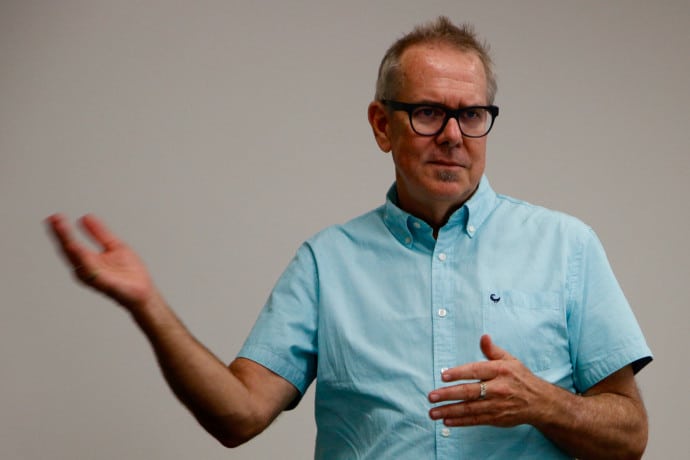“It’s about deciding what kind of ecosystem we want to see in the future. As humans we can manipulate this. It’s a political not a scientific question. But science can give valuable advice. There are value questions in everything we do. There is no question that the ecosystem will change and the animals will be affected. But we have to ask what we want from nature,” said Daniel Conley in a seminar on the future challenges to the Okavango Delta. Prof. Conley is professor in biogeochemistry at the Department of Geology at Lund University, a current STIAS fellow and a Wallenberg Scholar.

“We have to inform people about the possibilities so that something can happen, decisions can be made,” he continued.
Conley was updating STIAS fellows about progress in his project which looks at the unique nature of the Okavango Delta ecosystem and how this ecosystem biologically and geochemically processes elements, as well as the potential for environmental degradation of the Delta.
The Okavango Delta in Botswana is a World Heritage Site. It is created by seasonal flooding from rainfall in the Angola Highlands. Water is transported by the Okavango River into a delta and is lost primarily through transpiration by trees in the Kalahari Basin. The continued inflow of clean water coupled with various biogeochemical processes allows the Delta to remain a productive, freshwater wetland ecosystem.
“The Okavango Delta is an amazing place. About 12 000 km2 of wetlands combining permanent swamps, seasonal and occasional flood plains,” said Conley. “The water comes from the Angola Highlands but never makes it to the ocean. The water evaporates but remains fresh. The salts form unique salt islands – with dead soil, termite hills and no plants.”
“The unique plant and animal life adapt and thrive in this environment.”
“Our studies, which have involved collecting samples from the water, sediment and plants, have shown that it is a silica hotspot with 200 to 16 000 grams of silica per metre squared,” added Conley.
The Delta is a huge tourist attraction and there are rumoured development plans.
“All of this would have ecological effects,” said Conley. “Despite heavy controls, there is an ecological impact from roads, airstrips, the movement of vehicles and boats, noise pollution and sewerage. The Botswana government has tried very hard to minimise these and to introduce tourism policies based on sound principles that aim to protect the ecosystem – that minimise social and environmental impact; reinvest in conservation; provide maximum benefit for host communities; and, educate both visitors and locals.”
There is, however, intense political pressure for agricultural development of the Angola Highlands. “The question is whether we can sustain the ecosystem health of the Okavango Delta in the long run, while feeding an expanding world population,” said Conley.
“In 2015 media reports indicated that development of a 500 000-hectare rice farm in the Angolan Highlands was possible. Rice is highly water-intense farming and a development of this magnitude would undoubtedly affect the water reaching the Delta – both the quality and quantity, as well as the nutrient content. This would affect plant communities and animals in the Delta.”
“We estimate this development alone could reduce the water inflow by half, reduce the size of the Delta by up to 60% and that the nutrients in the water would change the species composition – possibly bringing in more invasive plant species.”
Thus far the development has not gone ahead but Conley is anxious that regional governments should be informed about the consequences of such initiatives on the ecosystem.
“We want to push the idea of a basin-wide monitoring system,” he continued. “We hope to assist in developing capacity in an African network to monitor and assess.”
“We are developing a database – working with the Okavango River Basin Water Commission (OKACOM) and the Okavango Research Institute at the University of Botswana. This will establish baseline trends in the river biogeochemistry which will then enable tracking and monitoring over time. There are data from studies published since 2005 and we have access to over 2400 samples.”
“The data have helped us to focus our efforts on the measurements that need to be made in a future monitoring programme.”
Comparing wetlands
“We are also doing a ‘tale of two wetlands’ – comparing the presently pristine Okavango Delta with the heavily agriculturally impacted Everglades in Florida in the USA,” continued Conley. “Decades of nutrient inputs from agriculture as well as changes to the water flow caused by humans have altered the vegetation and landscape of the Everglades.”
“There are many lessons to learn there about the effects of agricultural and other developments on such wetlands. Large sugar farms were built in the Everglades which have had massive effects on the geochemical composition of the area.”
These changes in the Everglades could provide hints into how agriculture in the upper watershed of the Okavango Delta may potentially alter the extent of seasonal flooding, and how nutrient inputs could change the distribution of plant and animal communities.
“It’s about using data to guess what might happen in the Okavango Delta and what we need to avoid,” added Conley.
“Changes in the Delta affect at least three countries – Botswana, Namibia and Angola – so the response has to involve transnational co-operation,” he said. “The environmental and national boundaries don’t match. It’s up to the countries and the people in the region to work together and decide what change is acceptable and what isn’t.”
Conley pointed out that developmental decisions have consequences that affect areas way into the future: “It can take hundreds of years for natural systems to clean up nutrient pollution”.
“We need to use science to inform governments and people so that decisions can be made based on solid information,” he said. “It’s about developing a cautionary tale.”
Michelle Galloway: Part-time media officer at STIAS
Photograph: Christoff Pauw
